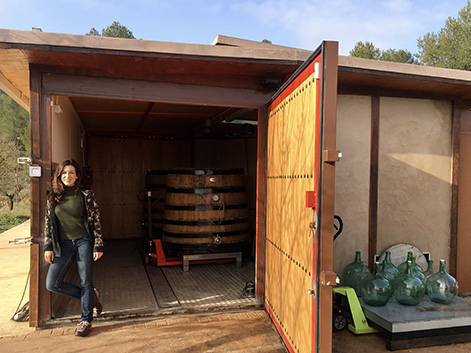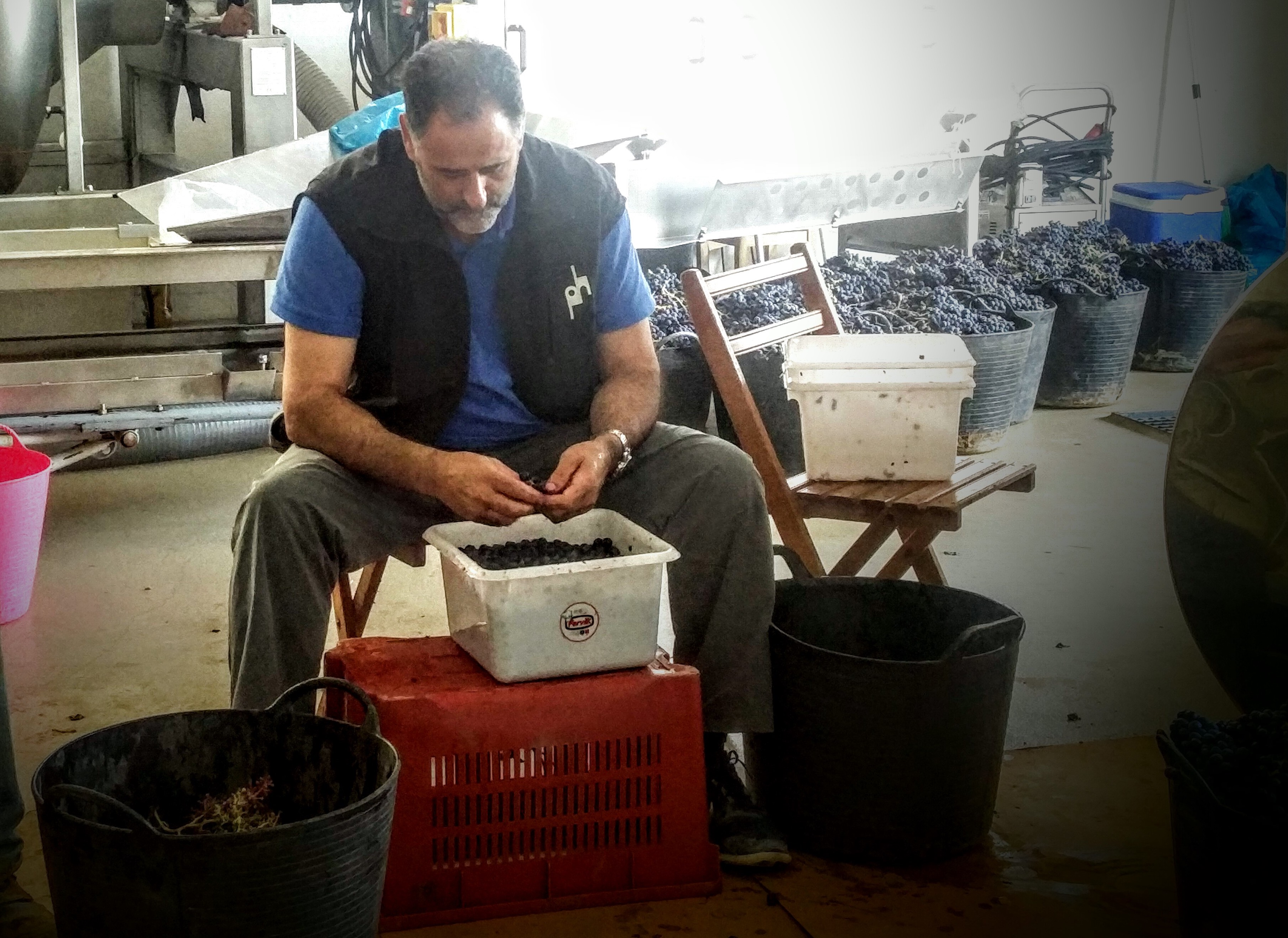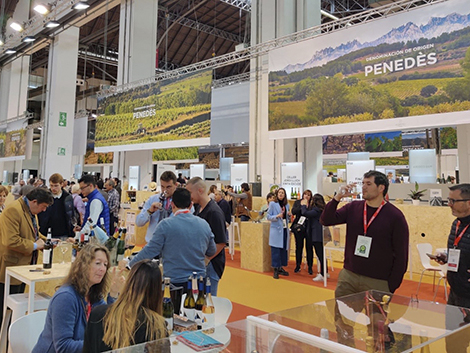Julia Casado, an artisan voice for Monastrell in Spain

How can young people get a start in wine business when they have not inherited vineyards or lack a winemaking tradition in their family? Julia Casado, 35, took a €35,000 loan to build a tiny modular cellar with prefabricated materials in Venta del Pino, a protected natural area in Bullas (Murcia, southeast Spain). Beyond being a place that she can call her own, she feels that it creates a strong bond with a landscape that captivated her.
In social media, Julia is @ladelterreno (from the land). This is how locals call Monastrell, the dominant grape variety in Murcia, and the name chosen by Julia for her first wine. In fact, she has been waving the Monastrell flag on natural wine fairs in France such as La Remise or La Goulayance.
Music and wine
It has not been an easy journey for this Murcia-born young woman. The daughter of a biologist and a psychologist, Julia's first passion was music. The first time she heard a cello, she knew she wanted to learn to play it.
In her second year studying agricultural engineering (“I didn't like it at all”, she confesses), music won the day –she moved to Germany to learn the language and become an orchestral musician. But the studies proved to be too demanding, she says: “I ended up overwhelmed and returned to Spain to finish my agricultural studies”.
At that moment of uncertainty, a rural development course in Havana, Cuba, changed the way she felt about music and agriculture. Julia finished her cello studies in Frankfurt and went on to study oenology at Miguel Hernández University in Elche. Interestingly, she wrote her thesis about blends of Monastrell with international grapes -that was the trend back in 2005.
“Wine and music have a lot in common with each other,” says Julia. “The concept of harmony is very much present in both, as is a certain degree of tension; and neither of them makes sense if they are not shared with others. There is a lot of coded information in music and wine. It's also interesting how sensitive wine is to vibrations”, she adds.
After several work experiences in wineries in Spain and abroad (Josef Biffar in Germany, a three-month stint at Vega Sicilia, one harvest at Ortega Fournier in Mendoza), Julia returned to Murcia and continued her training in Jumilla with Hacienda del Carche, Casa de la Ermita and Casa Castillo. La del Terreno 2015, her first vintage of this wine, was made in Casa Castillo. It had a white label which later changed to black.
Adventures in Bullas
“I didn't set out to have my own winery, but as I tasted more wines I realized that I would not be able to become a wine producer if I continued to work for others. In 2016 I jumped in my car and drove to Bullas. Many people had told me that the region was very different from the rest of Murcia: green and with vineyards at a higher elevation.”
Julia did what any producer would do to find out where the best vineyards are: she mingled in with the locals in the village bar. She soon discovered that a majority of vineyard owners were members of Bodegas del Rosario, the largest cooperative in Bullas. They encouraged her to start a partnership with the cooperative and become a member of the DO Bullas. She was also offered a space in their large facilities to produce her own wines, but Julia had already decided that she wanted to have a place of her own.
She rented a plot in the countryside next to a small renewable energies school and bought modular metal structures to enclose the 66 m² she was authorized to build on this protected area. The result: a fermentation room and an ageing cellar separated by a sliding door. Train sleepers support the entire structure.
For Julia, Bullas is “like a wine growing oasis where old vineyards have been preserved by many small landowners”. Nevertheless, her first vintage in the area was a nightmare. She had no electricity and lost a large quantity of grapes because she was unable to handle them in such precarious conditions. She managed to fill just over 1,000 bottles in the case of La del Terreno and 500 of La Cañada del Jinete, the name of the area where she built the winery. La Cañada del Jinete is a limited-production, single-vineyard Monastrell; the wine is fermented in clay and aged in foudre. Grapes for both wines are sourced from traditional, head-pruned vines.
“The uprooting of old vines is a worrying trend in the area, but growers know that small businesses like mine can contribute to preserve the area’s heritage,” she points out.
“The best thing about starting from scratch is that I have been able to choose the place and the vineyards I want to source grapes from,” says Julia. She doesn’t own any land because she cannot afford it but works closely with local grape growers.
“Perhaps it is because I got quite late into wine, but I really value coherence and ethics. I’m interested and passionate about producers who are deeply attached to their land. Seeing wine as art implies an emotional bond. I could not make wine in an area that I’m not in love with,” she points out.
A few thousand bottles
The modular building has got bigger and now includes a small, prefab apartment (Julia likes it this way because she can carry the whole thing anywhere if she ever has to), a container that acts as warehouse and a small porch built with the help of a friend to enjoy wine outdoors if the weather allows it (during our visit at the end of January, it was very cold with snow covering some vineyards). The photos below show how Julia built her winery.

She is particularly grateful to Joan Valencia from Cuvée 3000. This wine distributor, a champion of natural wine in Spain, wanted her wines in his portfolio from the very beginning. “At first, I didn't want to define myself as a natural wine producer,” Julia acknowledges, but now she is proud that producers like Thierry Puzelat call her to attend natural wine fairs in France.
Monastrell and Garnacha
The determination and sensitivity of Julia Casado are qualities that suit Monastrell. “It is seen as coarse, but I'm interested in its hidden delicacy”, she says. “It is a really expressive, multi-layered variety and manages to capture the landscape very well.” She describes it as a rustic tree bark wrapped in floral (violet) notes.
La del Terreno is made from vines over 50 years old planted on a stony, undulating terrain in Venta del Pino. “I like the orientation, the soil and the fact that 5% of the grapes are white and grow among the Monastrell. It is an aerated vineyard with gravely soils and silt-sand texture. There is a layer of clay underneath that retains water and allows vegetative growth even in hot years,” she notes.
Part of the wine is fermented with full clusters in open oak vats; the rest is fermented in concrete; ageing is done in concrete for about eight months. Julia’s Monastrell is a bit wilder and earthier than the standard in the area, but it really fills the palate. Featuring a remarkable long finish with violet and scrubland notes, its freshness makes it highly drinkable. La Cañada del Jinete has the mark of having been fermented in clay vessels. It is perhaps more extreme and easier to identify as a natural wine.
Julia’s wine to suit all palates is Ninja de las Uvas Garnacha which she makes jointly with Bodegas del Rosario. Grapes are sourced from the Aceniche valley, on the other side of the Lavia mountains. “I came across three Garnacha plots there that had never been worked separately,” she says. The irreverent name of the wine and the label are both Julia’s idea. It is a nod to the cooperative’s flagship brand Niño de las Uvas (child of grapes), inspired by a Roman sculpture found in Los Cantos, an archeological site nearby. It is a light, fresh, expressive wine, in line with the character of Garnacha.
“Garnacha is a lively, easy-to-drink variety, but it isn’t easy to understand. It is made in a similar way to a skin-contact white, pretty much like an herbal infusion. Despite reaching 17% abv. on the first vintage, alcohol, tannins and acidity felt so balanced that it seemed almost light. This would be unthinkable in Monastrell,” Julia explains.
Production has grown to 6,600 bottles for La del Terreno (€17.5 in Spain) and to 1,700 bottles for La Cañada del Jinete (around €25; it was not produced in 2017). There are about 4,000 bottles of Ninja de las Uvas (€13) but there is potential to fill 10,000 bottles in the future. With these modest amounts, which she sells in Spain and a few countries worldwide, Julia says that her business model is viable.
“In the end, I have applied everything I have learned in different fields, including a thesis in group management, to my daily work, both in terms of winemaking and sales,” she explains.
From her small corner in the world of wine, Julia Casado admires “free, self-made people and anything that is born out of adversity and expertise”. She says good-bye with these words: “Monolithic thinking brings impoverishment; diversity is a great asset for any area, but it implies a harmonic relationship between its various groups. Places with high standards in wine and music often display a great convergence of interests. Affinity is achieved with people who love the land. All the good work done by our neighbours contributes to the general wellbeing of a region.”

Amaya Cervera
A wine journalist with almost 30 years' experience, she is the founder of the award-winning Spanish Wine Lover website. In 2023, she won the National Gastronomy Award for Gastronomic Communication
NEWSLETTER
Join our community of Spanish wine lovers






